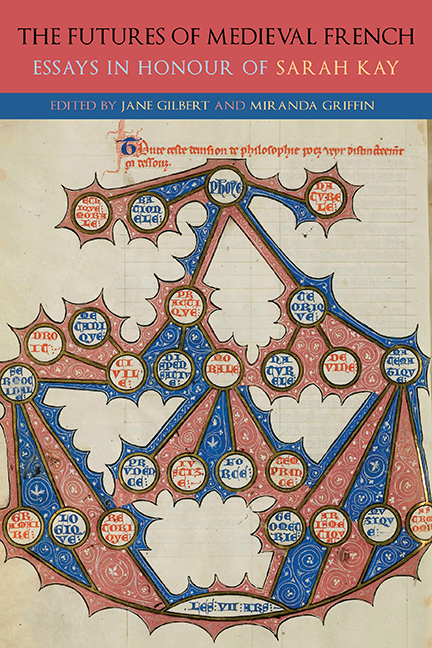Book contents
- Frontmatter
- Dedication
- Contents
- List of Illustrations
- List of Contributors
- List of Abbreviations
- Introduction
- Part I Subjectivity in Troubadour Poetry
- Part II The ‘Chansons de geste’ in the Age of Romance: Political Fictions
- Part III Courtly Contradictions: The Emergence of the Literary Object in the Twelfth Century
- Part IV The Place of Thought: The Complexity of One in French Didactic Literature
- Part V Parrots and Nightingales: Troubadour Quotations and the Development of European Poetry
- Part VI Animal Skins and the Reading Self in Medieval Latin and French Bestiaries
- Afterword
- General Bibliography
- List of Manuscripts
- Bibliography of Work by Sarah Kay
- Index
- Gallica
Troubadour Attachments
Published online by Cambridge University Press: 27 May 2021
- Frontmatter
- Dedication
- Contents
- List of Illustrations
- List of Contributors
- List of Abbreviations
- Introduction
- Part I Subjectivity in Troubadour Poetry
- Part II The ‘Chansons de geste’ in the Age of Romance: Political Fictions
- Part III Courtly Contradictions: The Emergence of the Literary Object in the Twelfth Century
- Part IV The Place of Thought: The Complexity of One in French Didactic Literature
- Part V Parrots and Nightingales: Troubadour Quotations and the Development of European Poetry
- Part VI Animal Skins and the Reading Self in Medieval Latin and French Bestiaries
- Afterword
- General Bibliography
- List of Manuscripts
- Bibliography of Work by Sarah Kay
- Index
- Gallica
Summary
A CENTRAL CLAIM OF Sarah Kay's Parrots and Nightingales is that in tracing troubadour quotations across time, we bear witness to ‘subjective change: the rearticulation of the subject of poetry from medieval courtly lover to Petrarchan poet’ (19), a change that marks the shift from the Middle Ages to the Renaissance. In this essay, I engage with the temporal moves Kay's book makes, thinking further about how quotations, and medieval literary works more broadly, can be considered to be non-human actors travelling across temporal boundaries.
I am inspired to do this by two conclusions Kay reaches in Parrots and Nightingales. She writes firstly about the extent to which ‘the act of repetition on which quotation [â¦] depends is, paradoxically, an engine of change’ (2). Secondly, she argues that quotation creates ‘a discourse of knowledge that connects together a network of potential subjects’ (16). In arguing that repetition of knowledge brings change, in maintaining that quotations are the ‘engines’ of that change, that they have agency, and in conceiving of the transmission of quotations as central to, and constitutive of, networks, I suggest that Kay's thinking comes close to that of Bruno Latour, although Kay does not engage explicitly with Latour's work in Parrots and Nightingales. Latour's work seeks to dismantle a view of history that emphasises the superiority of what he calls ‘the Moderns’ (Latour 1991). As part of this project, he exposes the fantasy of Double Click or ‘[DC]’, a modern expectation of unmediated knowledge, represented by the metaphor of the double click of a computer mouse. At the heart of Latour's Actor-Network Theory, or ANT, is the notion that knowledge is always mediated as it is transmitted; this mediation and transmission are the work of networks of actors, which are constantly in the process of assembling and reassembling. In his introduction to ANT Latour describes a flat ontology, undermining a modern view of human superiority by underscoring the importance of all actors, non-human as well as human, in the networks that make up our world (Latour 2005).
The implications of Latourian thought for literary criticism have been investigated by an increasing number of scholars in the years since the publication of Parrots and Nightingales.
- Type
- Chapter
- Information
- The Futures of Medieval FrenchEssays in Honour of Sarah Kay, pp. 250 - 263Publisher: Boydell & BrewerPrint publication year: 2021

